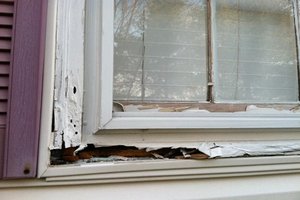
If water gets into cracks and under painted surfaces and doesn’t dry out, it can cause wood rot. Once wood rot takes hold, your only options are big-buck repairs and replacement of the rotted parts.
Left untreated, wood rot may spread, infecting other wood parts and possibly leading to structural damage.
That’s not all: The dampness that causes wood rot invites voracious termites. Bottom line: Because your house is made with a lot of wood — framing members, plywood sheathing, trim — there’s a lot to protect.
Look for Trouble Spots
The best defense against rot? Your eyes — once each year, make a tour of your house to inspect for:
That’s not all: The dampness that causes wood rot invites voracious termites. Bottom line: Because your house is made with a lot of wood — framing members, plywood sheathing, trim — there’s a lot to protect.
Look for Trouble Spots
The best defense against rot? Your eyes — once each year, make a tour of your house to inspect for:
- Cracks and holes in the caulking around windows, doors, dryer vents, etc.
- Stains under eaves, around fireplaces, and on interior ceilings.
- Sagging and leaking gutters and downspouts.
- Shrubbery and tree branches closer than 2 feet from siding and roofing.
- Peeling and cracked painted surfaces.
- Crawl space vents blocked with leaves and other debris.
- Dirt, leaves, and twigs between decking boards.
Probe for Rot
As you inspect your house, you should actively look for wood rot. It’s not always obvious; wood rot may occur below the outer surface of wood and underneath intact layers of paint.
If you suspect rot, use your fingers to press on wood surfaces and see if they feel soft or crumble easily. Use an awl to probe wood framing members. Typical trouble spots include:
- Where two pieces of trim meet.
- Siding butt joints, and where siding meets trim.
- Horizontal surfaces, such as window sills, door thresholds, and railings.
- Deck support posts.
- Exterior stair stringers that support steps.
- Fascia behind leaking gutters.
- Always use decay-resistant or pressure-treated lumber for decks. Wood that touches the ground should be pressure-treated lumber that’s rated for ground contact.
- When building an exterior project with wood, stain or paint all sides of each lumber piece before assembly.
- Don’t lean anything against your siding, such as old plywood, tools, and ladders.
- Clean your gutters regularly to prevent clogs that could cause water to back up and spill onto fascia and siding.
Read more: http://www.houselogic.com/home-advice/preventative-home-maintenance/how-to-prevent-wood-rot/#ixzz2pH3xVQEw
No comments:
Post a Comment